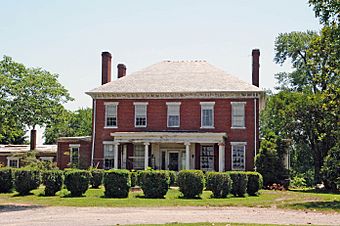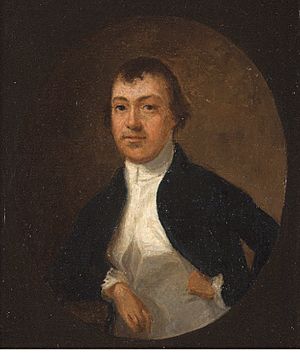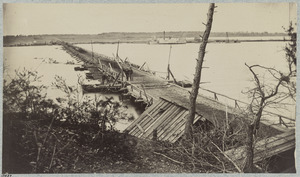Varina Farms facts for kids
|
Varina Plantation
|
|
 |
|
| Location | Henrico County, Virginia, USA |
|---|---|
| Nearest city | Varina, Virginia; Hopewell, Virginia |
| Area | 820 acres (330 ha) |
| NRHP reference No. | 77001489 |
Quick facts for kids Significant dates |
|
| Added to NRHP | April 29, 1977 |
Varina Farms, also known as Varina Plantation, is a very old farm and estate in Virginia. It was started way back in the 1600s. It sits right on the James River, about 10 miles (16 km) south of Richmond, Virginia.
This historic place is special because of its long history. It was officially added to the National Register of Historic Places in 1977. At that time, the protected area was about 820 acres (330 hectares). Even in 1977, Varina Farm was still a working farm, owned by a private family.
Contents
What Does Varina Farms Look Like?
The main house at Varina Farms was built in 1853. It's a two-story building made of brick. On one side, there's a kitchen connected to the main house by a long hallway.
The house faces the James River. On the river side, there are French doors that open up to the outside. A fancy porch with columns runs along the river side of the house. This porch was rebuilt in 1941 after a tornado damaged it. The roof was also changed after a storm in 1911.
Varina Farms covers a huge area of 2,200 acres (890 hectares). The historic part of the farm, which is listed as a special place, is 820 acres (330 hectares). There are also other old buildings on the farm, like a brick barn and sheds built before the Civil War.
A Look Back in Time: Varina's History
John Rolfe and Pocahontas's Home
In 1612, an English colonist named John Rolfe brought a special kind of tobacco to Jamestown. This tobacco was very popular in Europe. As it became a major crop for the struggling colony, Rolfe started his own farm, or plantation, around 1615. He named it Varina, after a type of Spanish tobacco.
Varina Plantation was across the river from another early settlement called Henricus. This community was started by Sir Thomas Dale in 1611.
Varina became the home of John Rolfe and his second wife, Rebecca, who was also known as Pocahontas. They got married in 1614 and lived at Varina for two years. Their son, Thomas Rolfe, was born there in 1615.
In 1616, John, Pocahontas, and Thomas traveled to London, England. Sadly, Pocahontas passed away there on March 21, 1617. She was buried in England. John Rolfe returned to Varina and managed the farm until 1622. He is thought to have died during a conflict known as the Indian massacre of 1622.
The Varina Settlement
After the 1622 conflict, the settlement of Henricus was no longer active. A new village called Varina began on the Varina plantation land. This area was quite large at first, but later it became known as Henrico. Over time, "Varina" mostly referred to the plantation itself.
Varina also became the main town, or county seat, for Henrico County. A courthouse was built there. Some of the Varina Plantation land was used for church purposes. By 1640, buildings like a church and courthouse were built on or near the plantation.
In the mid-1600s, the plantation property was divided. Part of it stayed with the Rolfe family. Eventually, it was owned by John Rolfe's great-grandson, Colonel John Bolling. Another part of the land was bought by Nathaniel Bacon.
Owners of the Plantation

Most of the plantation land was bought by the Randolph family of Virginia. Thomas Mann Randolph Sr. bought land at Varina for his son, Thomas Mann Randolph Jr.. Thomas Mann Randolph Jr. made it a very successful farm. He later became the 14th governor of Virginia. His wife, Martha, was the daughter of President Thomas Jefferson.
In 1825, Randolph sold the plantation to Pleasant Aiken. Aiken's son, Albert M. Aiken, built the current main house between 1853 and 1855.
Varina During the Civil War

During the American Civil War (1861–1865), the plantation was known as Aiken's Landing. It became a very important place for exchanging prisoners of war between the Union and Confederate armies. For example, on August 3, 1862, 6,000 soldiers were exchanged there.
In 1864, Union General Benjamin Butler and his troops fought a battle near the plantation. The plantation house was hit by cannonballs and bullets, and you can still see the marks on its west wall. Union troops also built a temporary bridge across the James River nearby to help them move towards Richmond. General Butler even used the plantation house as his main office during this time.
Varina is located close to a part of the Richmond National Battlefield Park, which protects important Civil War sites.
After the war, the house was sold several times. In 1910, the Stoneman family bought it. In 1977, Wiimer N. Stoneman, Jr. owned the property and continued to farm it using modern methods.
Discoveries from the Past
Experts have studied the land at Varina and found signs of human activity from long, long ago, even before the colonists arrived. They have also found objects from the 1600s and 1700s.
During one study, they found evidence of an old colonial building about 650 feet (200 meters) northeast of the main house. It's thought that other early buildings, like the first Varina Church, the glebe house (a church property), the first Henrico County courthouse, and a ferry crossing, might have been located on the Varina plantation land.





